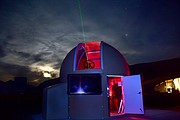New telescope explores Glacier's night skies
Each evening, as the last rays of sunlight fade from the striking mountain views of Glacier National Park, the park begins to showcase another side of its natural beauty — a starry side.
While most visitors come to the park for its amazing mountain views, spectacular hikes and abundant wildlife, Glacier National Park is quickly becoming known for another reason. With its location far away from major light pollution and crisp, clear mountain skies, the park is becoming one of the top destinations for amateur astronomers and stargazers.
With recent studies showing that as many as 80 percent of Americans live in areas where the Milky Way is obscured by light pollution, Glacier National Park is giving many tourists their first glimpses of what the night sky has to offer, from breathtaking views of the Milky Way to meteor showers and even an occasional glimpse of the northern lights.
According to Lee Rademaker, astronomy coordinator for the Hudson Bay District of Glacier, visitors don’t have to go far into the park to get amazing views of the night sky.
“The majority of our visitors are going to be stunned by the views you can get from the beach at Apgar by Lake McDonald. You don’t have to go far to really see some truly dark skies, especially compared to what most Americans have in their own backyards,” Rademaker said.
For those willing to brave the Going-to-the-Sun Road at night, the nighttime views from the top of Logan Pass can be some of the best in the park.
“You don’t need to drive to Logan Pass to really experience the night sky in Glacier, but if you do, you are going to be rewarded with a really dark sky with great sweeping views. The darkest parts of the park are the harder ones to get to, but they are worth it,” Rademaker added.
In April of 2017, Glacier National Park, and its Canadian counterpart Waterton Lakes National Park, became the first international park to receive a Dark Sky designation from the International Dark Sky Association (IDA). To achieve the designation, each park completed a significant number of lighting improvements to reduce light pollution as well as committing to completing further lighting retrofits in the coming years. The parks will also continue to educate visitors about the importance and significance of the dark night sky resource.
Since receiving this designation, Rademaker says the interest in the night sky in Glacier has shown steady growth.
The astronomy program in Glacier National Park began with a single volunteer astronomer in 2008 and a small number of programs for visitors. These days, the park astronomy events are attended by as many as 20,000 visitors each year as the program hosts viewing opportunities at St. Mary and Apgar four times a week from June to September as well as monthly star parties at Logan Pass in the summer months that have drawn as many as 600 visitors.
“We started out just doing a few weeks of astronomy for visitors to the park every year and now it has become a major component of our interpretation program,” Rademaker said.
The newest addition to the program was on display as St. Mary visitor center welcomed guests to its new observatory.
Located on the east side of the park, the St. Mary observatory is home to a new PlaneWave 20-inch CDK telescope — the second largest telescope in Montana and the largest public telescope in the National Park system.
Paid for by the Glacier National Park Conservancy, the telescope sits atop of a Paramount ME II robotic telescope mount and can be made to point at objects in the night sky with the click of a mouse. A pair 55-inch monitors mounted on the outside of the observatory provide high resolution images of objects in the night sky as seen through the scope’s lens, such as planets, globular clusters, distant galaxies and nebulae.
“With the observatory in place, it will make it easier for people to be able to view objects without having to squint to look through an eyepiece. It will also give our astronomers a little more time to discuss more of the meaning and history being the objects we are able to show to people,” Rademaker said.
The events were the final tuneup for the telescope, which will have an official dedication ceremony Aug. 22.
Along with its nighttime sky viewing opportunities, the Glacier National Park astronomy program has also been giving visitors the chance to get views of the sun through specialized telescopes during the daytime, but the sun has been somewhat quiet of late as it is currently at the lowest point for sunspot activity in its 11-year magnetic cycle.
For those wanting to check out the dark sky views inside the park, Rademaker offers a few pointers and words of advice. He reminds visitors to be safe by being aware of their surroundings and remembering that wildlife is active at night. He also stressed that visitors that do decide to make the trek to the park’s higher elevations for stargazing should be prepared for cold, windy weather, bring appropriate clothing and remember that camping is not allowed at the Logan Pass Visitor Center or on pullouts along the Sun Road. In addition, Rademaker said that it is important to allow one’s eyes to adjust to the dark to get the best view of the night sky, a process that can take up to 30 minutes. He said to make sure to avoid looking at car headlights, cell phone screens or other sources of artificial light.
For more information, visit the National Park System’s Night Sky Program at https://www.nps.gov/subjects/nightskies/stargaze.htm.
Telescope Dedication Ceremony
Aug. 22
St. Mary Visitor Center
9 a.m.-11 a.m. - Open House
6:15-7:30 p.m. - Guest Speakers
7:30-9:30 p.m. - Open House
9:30-midnight - Star Viewing




